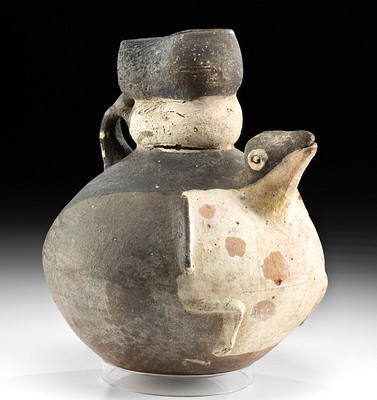Fossilized Stingray Heliobatis in Limestone Matrix
Lot 15
About Seller
Artemis Gallery
686 S Taylor Ave, Ste 106
Louisville, CO 80027
United States
Selling antiquities, ancient and ethnographic art online since 1993, Artemis Gallery specializes in Classical Antiquities (Egyptian, Greek, Roman, Near Eastern), Asian, Pre-Columbian, African / Tribal / Oceanographic art. Our extensive inventory includes pottery, stone, metal, wood, glass and textil...Read more
Estimate:
$500 - $750
Absentee vs Live bid
Two ways to bid:
- Leave a max absentee bid and the platform will bid on your behalf up to your maximum bid during the live auction.
- Bid live during the auction and your bids will be submitted real-time to the auctioneer.
Bid Increments
| Price | Bid Increment |
|---|---|
| $0 | $25 |
| $300 | $50 |
| $1,000 | $100 |
| $2,000 | $250 |
| $5,000 | $500 |
| $10,000 | $1,000 |
| $20,000 | $2,500 |
| $50,000 | $5,000 |
| $100,000 | $10,000 |
| $200,000 | $20,000 |
About Auction
By Artemis Gallery
Oct 28, 2021
Set Reminder
2021-10-28 12:00:00
2021-10-28 12:00:00
America/New_York
Bidsquare
Bidsquare : Fauna, Flora, Stone & Bones - Fall Edition
https://www.bidsquare.com/auctions/artemis-gallery/fauna-flora-stone-bones---fall-edition-7768
Join us for a very special early Fall auction featuring fabulous fossils, rocks, and minerals, plus art depicting flora and fauna from antiquity to present day. This is one sale you won't want to miss! Artemis Gallery info@artemisgallery.com
Join us for a very special early Fall auction featuring fabulous fossils, rocks, and minerals, plus art depicting flora and fauna from antiquity to present day. This is one sale you won't want to miss! Artemis Gallery info@artemisgallery.com
- Lot Description
North America, Western United States, Wyoming, Kemmerer, Green River Formation, Eocene Period, ca. 56 to 33 million years ago. This is a remarkable fossilized stingray of the extinct genus Heliobatis radians within a limestone matrix. The ray presents an ovoid body and narrow tail that preserved some of the minute spines! From the posterior, just above the tail are the remains of a pelvic fin. These rays are believed to have swum along the ocean floor, searching for prey; they have triangular teeth for feeding on small fish and crustaceans. Like sharks, they have an inner skeleton made of cartilage, and as a result, it is rare to find fully preserved examples of this species, but this fossil captures some miniscule details that normally are lost to natural decay! Size of stingray: 4" L x 2" W (10.2 cm x 5.1 cm); stone matrix: 6" L x 6.5" W (15.2 cm x 16.5 cm)
Provenance: private Hagar collection, Wildwood, Missouri, USA
All items legal to buy/sell under U.S. Statute covering cultural patrimony Code 2600, CHAPTER 14, and are guaranteed to be as described or your money back.
A Certificate of Authenticity will accompany all winning bids.
PLEASE NOTE: Due to recent increases of shipments being seized by Australian & German customs (even for items with pre-UNESCO provenance), we will no longer ship most antiquities and ancient Chinese art to Australia & Germany. For categories of items that are acceptable to ship to Australia or Germany, please contact us directly or work with your local customs brokerage firm.
Display stands not described as included/custom in the item description are for photography purposes only and will not be included with the item upon shipping.
#160034Fossil is within the natural stone matrix. Tip of tail overhangs the matrix edge. Due to excavation process, a piece is reattached to the tip of tail and remains of visible adhesive are visible on this area. Body is faint but the tail has great details!Condition
- Shipping Info
-
All shipping is handled in-house for your convenience. Your invoice from Artemis Gallery will include shipping calculation instructions. If in doubt, please inquire BEFORE bidding for estimated shipping costs for individual items.
-
- Buyer's Premium



 EUR
EUR CAD
CAD AUD
AUD GBP
GBP MXN
MXN HKD
HKD CNY
CNY MYR
MYR SEK
SEK SGD
SGD CHF
CHF THB
THB













